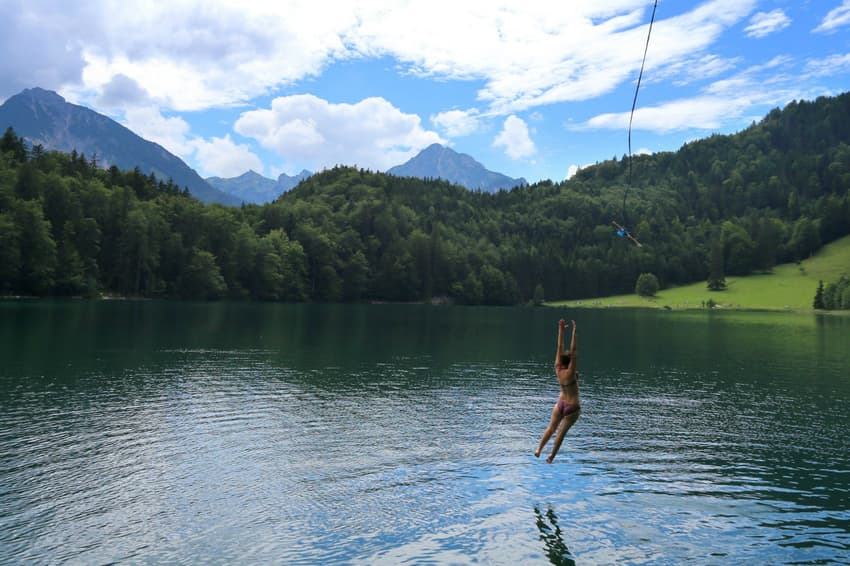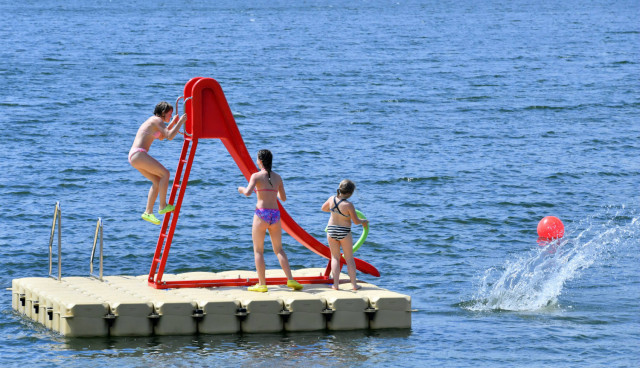All you need to know about keeping safe while swimming this summer

We've skipped spring and gone straight to summer; as such you're probably ready to cool off with a swim in a Bad or a See. After over 400 people drowned last year, the German lifesaving society has come up with some swimming tips and has debunked some swimming myths.
A recent study by the German Life-Saving Society (DLRG) reported that 404 people drowned in Germany in 2017. The majority of these deaths (329) occurred in open water.
“Relatively few bodies of inland water have a lifeguard on duty. The risk of drowning in unguarded lakes and rivers is therefore much higher than on the coast or in swimming pools”, said Achim Haag, president of the DLRG.
In May, there were at least two deadly swimming accidents over a summer's weekend.
Chances are though that you can't wait to jump in the 'See', especially when taking into account that 98 percent of German lakes meet the EU's bathing water standard.

Photo: DPA
So, what can you do to protect yourself when swimming?
We’ve all been told that we can’t go swimming straight after eating, but is this true?
A study conducted by the American Red Cross found nothing life-threatening about swimming on a full stomach.
Unsurprisingly, however, swimming is “more difficult” after you’ve had a bite to eat, according to Martin Holzhause, a spokesperson for the DLRG.
There is some truth to the old wives’ tale though: the DLRG warn not to let kids swim straight after a meal as they may be sick or swallow water.
You shouldn’t be starving before you swim either though, as it requires a lot of energy - in around 10 minutes you’ll use up the energy from an apple.
Is it true that your heart stops if you jump into cold water?
Whereas in warm water blood flows more to your arms and legs, jumping into cold water means that your blood vessels contract and pump blood to your heart.
“This puts a great strain on the right ventricle and can lead to arrhythmias in people with unidentified heart problems - including children”, said Martin Halle, Medical Director at the Centre for Prevention and Sports Medicine at the Technical University in Munich.
When cold water hits the skin, “heart rate and blood pressure drop rapidly and sometimes very sharply”, says Halle. On rare occasions this can be fatal, but it more commonly leads to loss of orientation or unconsciousness in the water.
Do wet clothes make survival more difficult in an emergency?
Clothes increase resistance when swimming, meaning you need more strength and you’ll go slower.
However, it’s a misconception that wet clothes drag you down; they could even be helpful in certain situations according to Michael Tipton and Frank Golden in their book on survival at sea.
Movement can trap air in the clothes which will remain on your body for a while; in an emergency, this provides important heat in cold waters.
What can protect you from drowning?
Accidents often happen because swimmers overestimate their abilities. When swimming, your body not only has to fight against the resistance, but it must also adapt to the constantly changing temperatures — both requiring a lot of energy.
A cold shower before swimming could prepare you for water temperatures.
Naturally if you have a cold or an infection, swimming should be off the cards. Otherwise you run the risk of over-exerting your body and your cardiovascular system is put under a lot of stress.
Alcohol also increases the risk of overestimating yourself, obviously.
Why is it difficult to save someone drowning?
When people have an emergency in the water, they tend to panic: they thrash around and try to hold onto something. The DLRG say that in an emergency, you should call for help and see if you can find anything to throw to the person in the water for them to hold on to.
How should swimmers react if they realise that their strength is going and they can’t make it to shore?
Find a quiet place and regain your strength in one of two positions (which can be practiced safely at an appropriate occasion):
-
Float in the water on your back and dip the back of your head (up to your ears) into the water; pull your chin up slightly towards your chest. Make small paddling movements with your hands.
-
Like a frog, lie in the water on your stomach. Your face should lay in the water and you should exhale calmly and slowly into the water. Lift your head above the water to inhale.
p.p1 {margin: 0.0px 0.0px 0.0px 0.0px; font: 11.0px 'Helvetica Neue'; color: #000000; -webkit-text-stroke: #000000}
p.p2 {margin: 0.0px 0.0px 0.0px 0.0px; font: 11.0px 'Helvetica Neue'; color: #000000; -webkit-text-stroke: #000000; min-height: 12.0px}
li.li1 {margin: 0.0px 0.0px 0.0px 0.0px; font: 11.0px 'Helvetica Neue'; color: #000000; -webkit-text-stroke: #000000}
li.li3 {margin: 0.0px 0.0px 0.0px 0.0px; font: 13.2px 'Helvetica Neue'; color: #000000; -webkit-text-stroke: #000000}
span.s1 {font-kerning: none}
span.s2 {font: 13.2px 'Helvetica Neue'}
span.s3 {font: 11.0px 'Helvetica Neue'; font-kerning: none}
ul.ul1 {list-style-type: disc}
FOR MEMBERS: A guide to Berlin's hidden swimming spots - from the woman who wrote the book on it
p.p1 {margin: 0.0px 0.0px 0.0px 0.0px; font: 11.0px 'Helvetica Neue'; color: #000000; -webkit-text-stroke: #000000}
p.p2 {margin: 0.0px 0.0px 0.0px 0.0px; font: 11.0px 'Helvetica Neue'; color: #000000; -webkit-text-stroke: #000000; min-height: 12.0px}
span.s1 {font-kerning: none}
Comments
See Also
A recent study by the German Life-Saving Society (DLRG) reported that 404 people drowned in Germany in 2017. The majority of these deaths (329) occurred in open water.
“Relatively few bodies of inland water have a lifeguard on duty. The risk of drowning in unguarded lakes and rivers is therefore much higher than on the coast or in swimming pools”, said Achim Haag, president of the DLRG.
In May, there were at least two deadly swimming accidents over a summer's weekend.
Chances are though that you can't wait to jump in the 'See', especially when taking into account that 98 percent of German lakes meet the EU's bathing water standard.

Photo: DPA
So, what can you do to protect yourself when swimming?
We’ve all been told that we can’t go swimming straight after eating, but is this true?
A study conducted by the American Red Cross found nothing life-threatening about swimming on a full stomach.
Unsurprisingly, however, swimming is “more difficult” after you’ve had a bite to eat, according to Martin Holzhause, a spokesperson for the DLRG.
There is some truth to the old wives’ tale though: the DLRG warn not to let kids swim straight after a meal as they may be sick or swallow water.
You shouldn’t be starving before you swim either though, as it requires a lot of energy - in around 10 minutes you’ll use up the energy from an apple.
Is it true that your heart stops if you jump into cold water?
Whereas in warm water blood flows more to your arms and legs, jumping into cold water means that your blood vessels contract and pump blood to your heart.
“This puts a great strain on the right ventricle and can lead to arrhythmias in people with unidentified heart problems - including children”, said Martin Halle, Medical Director at the Centre for Prevention and Sports Medicine at the Technical University in Munich.
When cold water hits the skin, “heart rate and blood pressure drop rapidly and sometimes very sharply”, says Halle. On rare occasions this can be fatal, but it more commonly leads to loss of orientation or unconsciousness in the water.
Do wet clothes make survival more difficult in an emergency?
Clothes increase resistance when swimming, meaning you need more strength and you’ll go slower.
However, it’s a misconception that wet clothes drag you down; they could even be helpful in certain situations according to Michael Tipton and Frank Golden in their book on survival at sea.
Movement can trap air in the clothes which will remain on your body for a while; in an emergency, this provides important heat in cold waters.
What can protect you from drowning?
Accidents often happen because swimmers overestimate their abilities. When swimming, your body not only has to fight against the resistance, but it must also adapt to the constantly changing temperatures — both requiring a lot of energy.
A cold shower before swimming could prepare you for water temperatures.
Naturally if you have a cold or an infection, swimming should be off the cards. Otherwise you run the risk of over-exerting your body and your cardiovascular system is put under a lot of stress.
Alcohol also increases the risk of overestimating yourself, obviously.
Why is it difficult to save someone drowning?
When people have an emergency in the water, they tend to panic: they thrash around and try to hold onto something. The DLRG say that in an emergency, you should call for help and see if you can find anything to throw to the person in the water for them to hold on to.
How should swimmers react if they realise that their strength is going and they can’t make it to shore?
Find a quiet place and regain your strength in one of two positions (which can be practiced safely at an appropriate occasion):
- Float in the water on your back and dip the back of your head (up to your ears) into the water; pull your chin up slightly towards your chest. Make small paddling movements with your hands.
- Like a frog, lie in the water on your stomach. Your face should lay in the water and you should exhale calmly and slowly into the water. Lift your head above the water to inhale.
p.p1 {margin: 0.0px 0.0px 0.0px 0.0px; font: 11.0px 'Helvetica Neue'; color: #000000; -webkit-text-stroke: #000000} p.p2 {margin: 0.0px 0.0px 0.0px 0.0px; font: 11.0px 'Helvetica Neue'; color: #000000; -webkit-text-stroke: #000000; min-height: 12.0px} li.li1 {margin: 0.0px 0.0px 0.0px 0.0px; font: 11.0px 'Helvetica Neue'; color: #000000; -webkit-text-stroke: #000000} li.li3 {margin: 0.0px 0.0px 0.0px 0.0px; font: 13.2px 'Helvetica Neue'; color: #000000; -webkit-text-stroke: #000000} span.s1 {font-kerning: none} span.s2 {font: 13.2px 'Helvetica Neue'} span.s3 {font: 11.0px 'Helvetica Neue'; font-kerning: none} ul.ul1 {list-style-type: disc}
FOR MEMBERS: A guide to Berlin's hidden swimming spots - from the woman who wrote the book on it
p.p1 {margin: 0.0px 0.0px 0.0px 0.0px; font: 11.0px 'Helvetica Neue'; color: #000000; -webkit-text-stroke: #000000} p.p2 {margin: 0.0px 0.0px 0.0px 0.0px; font: 11.0px 'Helvetica Neue'; color: #000000; -webkit-text-stroke: #000000; min-height: 12.0px} span.s1 {font-kerning: none}
Join the conversation in our comments section below. Share your own views and experience and if you have a question or suggestion for our journalists then email us at [email protected].
Please keep comments civil, constructive and on topic – and make sure to read our terms of use before getting involved.
Please log in here to leave a comment.